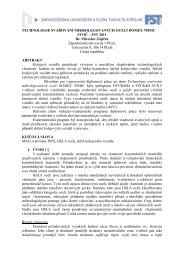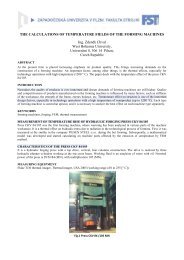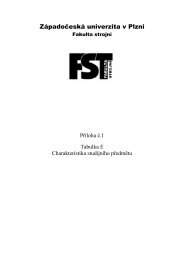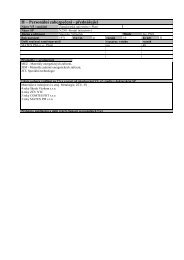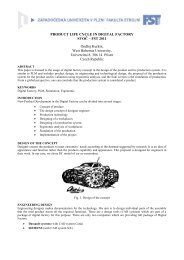FATIGUE ANALYSIS OF CLAMPING JAW FOR HORIZONTAL ...
FATIGUE ANALYSIS OF CLAMPING JAW FOR HORIZONTAL ...
FATIGUE ANALYSIS OF CLAMPING JAW FOR HORIZONTAL ...
You also want an ePaper? Increase the reach of your titles
YUMPU automatically turns print PDFs into web optimized ePapers that Google loves.
A formal fatigue evaluation accounts for each of these factors as it calculates how "used up" a certain componentwill become during its anticipated life cycle.As any rating procedure, fatigue life estimation evaluates the expected operational stress during a specifiedservice life with permissible component stress and depends on the given material, component geometry (relatedstress gradient) of the respective component, stress, surface, etc.Uncertainties may occur due to the high number of parameters, it means that calculations should be carried outcarefully and thoroughly. Operational experience and the application of relative fatigue life estimation can helpto reduce uncertainties.Methods for fatigue analysis are most frequently based on Coffin-Manson relation between deformation, stressedand number of loading cycles. This relation is described by the following equation:∆εσa=2 E∆εp+2σ 'f=Eb( 2N') + ε ' ( 2N) cfff(2)where σ 'fis fatigue strength coefficient, ε 'fis fatigue ductility coefficient related to fatigue process, b isexponent of strength and c is fatigue ductility exponent. The usual way of presenting fatigue test is to plot elasticand plastic strain range against number of loading cycles. The material curve is divided into elastic and plasticcomponent, and their intersection point divides the number of cycles into low cycle fatigue (LCF) and high cyclefatigue (HCF).3.2 Fatigue computationAs a result of load the dynamic deterministic stress-time history occurs in this cause. Values of a stress (and theloading force) change according to rotation of headstock. For an instance, for variant A – clamping of shaft is anexternal loading F c on the upper jaw and F c + Q on the bellow jaw.The fatigue analysis will be counted using with Ansys FE code [1]. The program allows an investigation ofseveral locations, events and loading sets in one analysis. There are also several methods how fatigue analysiscan be determined, this analysis will use results of stresses from previous structural analysis.The S-N curve was created by two known points, which are shown in Table 1.Number of cyclesNStress S[MPa]1.10 4 595,7031.10 7 326,61Table 1. S-N curveNext step is to determine an allowed number of loading cycles. This device is typical example of variableloading according to customer’s requirements. Generally, a fatigue computation with maximal values of loadingisn’t appropriate because it means that device is investigated in a way which is not actually close to real loading.It is assumed that a service life of clamping device is 10000 hours; it means 3.10 8 cycles in case if equivalentrevolutions are half to maximal. Anyway, a service life, hours and revolutions linear dependence; it can be alsoconsider for instance a service life 20000 hours if a quarter of maximum revolutions.Allowed live cycles are much higher than last data from S-N curve, it means that after this last point the stress Sisn’t changed against to a number of cycles.
REFERENCES[1] Ansys Release 9.0 Documentation, 2006.[2] Mayer A. SFT/FEMSITE – v1.2 Theory, Steyer-Daimler-Puch Fahrzeugtechnic AG&Co KG, 1999.[3] Kramberger J., Šraml M., Potrč I., Flašker J. Numerical calculation of bending fatigue life of thin-rim spurgears, Engineering Fracture Mechanics, 2004.[4] Kramberger J., Šraml M., Glodež S., Flašker J. Potrč I. Computation model for the analysis of bendingfatigue in gears, Engineering Fracture Mechanics, 2003.[5] Glodež S., Šraml M., Kramberger J. A computation model for determination of service life of gears,Engineering Fracture Mechanics, 2002.[6] Šraml M., Flašker J. Potrč I. Numerical procedure for predicting the rolling contact fatigue crack initiation,Engineering Fracture Mechanics, 2002.[7] Mercer I., Malton G. Draper J. Investigation fatigue failures using analysis and testing – some do’s anddon’ts, EIS Seminar 2003.Ing. Jan Vojna, Západočeská univerzita v Plzni. Univerzitní 22, 306 14 Plzeň, tel.: 377 638 251,e-mail: vojak@kks.zcu.cz



